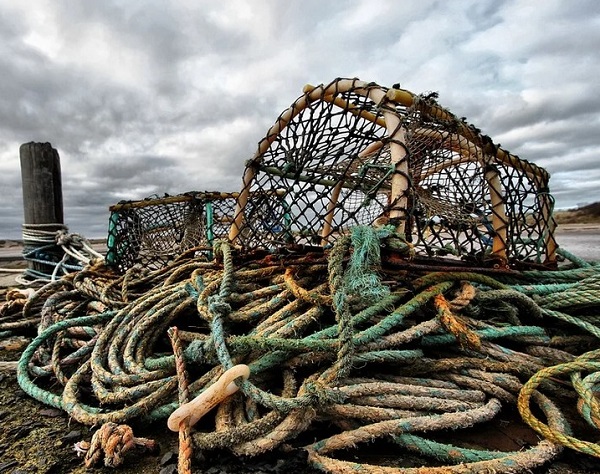BALTIMORE, MD—In response to the lowest abundance of crabs ever counted in the 33-year history of the Chesapeake Bay’s winter blue crab dredge survey, fishery managers at the Maryland Department of Natural Resources and Virginia Marine Resources Commission this week adopted new regulations designed to reduce the crab harvest.
The regulations aim to help the overall Chesapeake crab population rebound. The new restrictions are among the limited options fishery managers can take now to protect the Bay’s blue crab population as scientists examine other, long-term factors on the species such as pollution, loss of habitat, and predation from invasive species.
The Virginia Marine Resources Commission on Wednesday extended lower harvest limits for the spring crab pot fishery and introduced lower limits for the fall crab pot fishery.
Maryland fishery managers made changes to both commercial and recreational harvest limits, with recreational harvest limits being cut in Maryland from two bushels to one bushel per day.
Chesapeake Bay Foundation’s Maryland Senior Fisheries Scientist Allison Colden issued the following statement:
“In the face of a worrisome decline in the Chesapeake Bay’s blue crab population, it is encouraging that Virginia and Maryland are taking steps to protect the iconic crab fishery.
“These modest changes to crab harvest limits will help ensure harvest rates do not exceed levels that could threaten the crab population. And, for the first time ever, Maryland is placing bushel limits on male crabs in a change that underscores the need to boost overall reproduction.
“However, these fishery changes are a first step. We must also address the many factors threatening Chesapeake blue crabs, including poor water quality, loss of key habitat such as underwater grasses, and the proliferation of blue catfish and other invasive predators. Targeted research into these factors’ impact on the crab population is a critical next step to help protect communities that depend on blue crabs.”
“We also recommend conducting a new comprehensive stock assessment to better understand the Bay’s blue crab population and how management can work to ensure a healthy Chesapeake population in the future.”
Maryland’s new blue crab fishery regulations can be found here under “blue crab.”
Meanwhile, this summer the Chesapeake Bay’s dead zone is predicted to be smaller than average. Researchers from the Chesapeake Bay Program, the University of Maryland Center for Environmental Science, University of Michigan, and U.S. Geological Survey attribute the decline to the below average amount of water entering the Bay from the watershed’s tributaries this past spring, as well as decreased nitrogen and phosphorus pollution from jurisdictions within the watershed.
The Bay’s dead zone causes habitat loss for various types of marine life including fish, blue crabs, oysters and underwater grasses.
Under the Chesapeake Clean Water Blueprint, in 2010 the Bay jurisdictions agreed to cut nitrogen, phosphorus, and sediment pollution in the Bay and its waterways to science-based numeric limits. The Blueprint gives them until 2025 to adopt the policies and practices needed to achieve those reductions. Of the three major Bay states, Virginia is largely on track to meet its commitments, Maryland must ramp up its efforts to reduce pollution from agriculture as well as ensure its sewage treatment plants are in compliance with their permits, and Pennsylvania is significantly off track.
The Susquehanna River delivers approximately 40 percent of the nitrogen pollution that causes dead zones, with the vast majority of that coming from Pennsylvania. Pennsylvania’s plan to meet its requirements, however, is sorely deficient. By its own accounting, the Commonwealth needs to increase spending by more than $300 million dollars or more annually to implement a plan that does not even achieve the requirements.
CBF and the Attorneys General for Virginia, the District of Columbia, Maryland, and Delaware are suing EPA over its failure to hold Pennsylvania accountable.
Following the prediction Beth McGee, Chesapeake Bay Foundation Director of Science and Agricultural Policy, issued the following statement:
“As a result of efforts to implement the Blueprint, the Bay is trending in the right overall direction, but it still has a long way to go—a hill made much steeper due to climate change. And again this year, large portions of the Chesapeake Bay and its tidal rivers will have insufficient oxygen to support a healthy ecosystem.
“The Bay states are relying on reducing pollution from agriculture as the primary means of meeting Blueprint commitments. Many conservation practices have the added benefits of helping to reduce greenhouse gases, making farms more resilient to climate change with its more intense storms, and improving the farmer’s bottom line. But while farmers are willing to invest in conservation practices, they cannot foot the bill alone.
“The U. S. Department of Agriculture must provide more funding for conservation and technical assistance and the Pennsylvania legislature should establish a state agricultural cost share program. At the same time, EPA must hold the states, especially Pennsylvania, accountable to meet pollution reduction requirements from all sources. Without those state and federal efforts, the Chesapeake Clean Water Blueprint will be yet another in the history of failed Bay restoration efforts.”
Photo via Pixabay
Do you value local journalism? Support NottinghamMD.com today.

